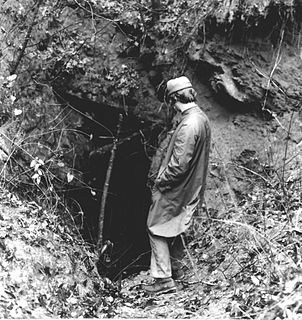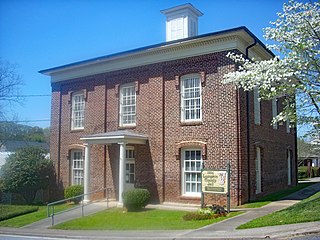
Lumpkin County is a county located in the north central portion of the U.S. state of Georgia. As of the 2010 census, the population was 29,966. Its county seat is Dahlonega.

Hall County is a county located in the north central portion of the U.S. state of Georgia. As of the 2010 census, the population was 179,684. The county seat is Gainesville. Hall County comprises the Gainesville, GA Metropolitan Statistical Area, which is also part of the Atlanta-Athens-Clarke County-Sandy Springs, GA Combined Statistical Area.

The city of Dahlonega is the county seat of Lumpkin County, Georgia, United States. As of the 2010 census, the city had a population of 5,242, and in 2018 the population was estimated to be 6,884.

The Dahlonega Mint was a former branch of the United States Mint built during the Georgia Gold Rush to help the miners get their gold assayed and minted, without having to travel to the Philadelphia Mint. It was located at in Dahlonega, Lumpkin County, Georgia. Coins produced at the Dahlonega Mint bear the "D" mint mark. That mint mark is used today by the Denver Mint, which opened many years after the Dahlonega Mint closed. All coins from the Dahlonega Mint are gold, in the $1, $2.50, $3, and $5 denominations, and bear dates in the range 1838–1861.

Auraria is a ghost town in Lumpkin County, Georgia, United States, southwest of Dahlonega. Its name derives from aurum, the Latin word for gold. In its early days, it was also known variously as Dean, Deans, Nuckollsville, and Scuffle Town.

The Calhoun Mine is perhaps the oldest and best-known mine in Lumpkin County, Georgia. When gold was discovered in Lumpkin County in 1828, which led to the Georgia Gold Rush in 1829, it was discovered on 239 acres (0.97 km2) owned by Robert Obar. After at least two intermediary sales, the land was purchased by Senator John C. Calhoun of South Carolina, who was also the 7th Vice President of the United States. Calhoun started a mining company to mine the land and later allowed his son-in-law Thomas Green Clemson, the founder of Clemson University, to manage it. The ore deposit was a very rich deposit and, according to an 1856 letter from Clemson to his brother-in-law, was still producing significant quantities of gold nearly 30 years after its initial discovery on the land. This mine - along with the Consolidated Mine and the Loud Mine - were some of the most productive mines in the Georgia Gold Belt.

The Consolidated Mine was a gold mine in Lumpkin County, Georgia, United States, just east of Dahlonega. Like most of the area around Dahlonega, the placer mining on the land on which the mine is located probably started during the Georgia Gold Rush. By 1880, the placer deposits were exhausted and the land was down to hard rock. Gold was soon discovered in a huge quartz vein system, and mined. "The richest acre" was mined deep into the ground, and the resulting shaft became known as the "Glory Hole.”

The Georgia State Capitol is an architecturally and historically significant building in Atlanta, Georgia, United States. The building has been named a National Historic Landmark which is listed on the National Register of Historic Places. As the primary office building of Georgia's government, the capitol houses the offices of the governor, lieutenant governor, and secretary of state on the second floor, chambers in which the General Assembly, consisting of the Georgia State Senate and Georgia House of Representatives, meets annually from January to April. The fourth floor houses visitors' galleries overlooking the legislative chambers and a museum located near the rotunda in which a statue of Miss Freedom caps the dome.
The Chestatee River is a 32.76-mile-long (52.72 km) river in the Appalachian Mountains of northern Georgia, USA.

The Dahlonega Gold Museum Historic Site is a Georgia state historic site located in Dahlonega that commemorates America's first gold rush and the mining history of Lumpkin County. The museum is housed in the historic Old Lumpkin County Courthouse built in 1836 and located in the center of the town square. It is the oldest surviving county courthouse in the state. The museum houses many artifacts from the gold rush of 1836, including gold nuggets, gold coins, and gold panning equipment, as well as an educational film and gift shop.

The Georgia Gold Rush was the second significant gold rush in the United States and the first in Georgia, and overshadowed the previous rush in North Carolina. It started in 1829 in present-day Lumpkin County near the county seat, Dahlonega, and soon spread through the North Georgia mountains, following the Georgia Gold Belt. By the early 1840s, gold became difficult to find. Many Georgia miners moved west when gold was found in the Sierra Nevada in 1848, starting the California Gold Rush. Since the 16th century, American Indians in Georgia told European explorers that the small amounts of gold which they possessed came from mountains of the interior. Some poorly documented accounts exist of Spanish or French mining gold in North Georgia between 1560 and 1690, but they are based on supposition and on rumors passed on by Indians. In summing up known sources, W.S. Yeates observed: "Many of these accounts and traditions seem to be quite plausible. Nevertheless, it is hardly probable that the Spaniards would have abandoned mines which were afterwards found to be quite profitable, as those in North Georgia."

William Pierce Price was a politician who served in the United States House of Representatives. Price was born in Dahlonega, Georgia.
North Georgia College & State University was an institution of higher education that began as a branch of the Georgia College of Agriculture and Mechanical at the University of Georgia in 1873. It was merged in 2013 with Gainesville State College to create the University of North Georgia.

Northeast Georgia is a region of Georgia in the United States. The northern part is also in the north Georgia mountains, while the southern part is still hilly but much flatter in topography. Northeast Georgia is also served by the Asheville/Spartanburg/Greenville/Anderson market.

The University of North Georgia (UNG) is a public senior military college with multiple campuses in Georgia. It is part of the University System of Georgia. The university was established on January 8, 2013 by a merger of North Georgia College & State University and Gainesville State College. The regents announced plans for the merger on January 10, 2012, and the name of the new school was announced on May 8, 2012. The Southern Association of Colleges and Schools (SACS) approved the consolidation December 11, 2012. The combined institution has campus locations in Dahlonega, Gainesville, Watkinsville, Blue Ridge, and Cumming.

The Joseph Henry Lumpkin House was built in the 1830s, and purchased by its namesake, the first chief justice of the Georgia Supreme Court, in 1842.
The University of North Georgia was first established at the site of its current campus in Dahlonega, Georgia in 1873 as North Georgia Agricultural College (NGAC). In 2013 North Georgia College & State University was consolidated with Gainesville State College to form the University of North Georgia.

Holly Theatre is a historic theater in Dahlonega, Lumpkin County, Georgia, which was constructed as a movie theater in 1948, and is currently operated as a non-profit theatrical venue. It puts on performances of musicals and straight plays, generally five mainstage productions a season, and a varying number of children's shows.

The Old Lumpkin County Jail is a historic jail building in Dahlonega, Georgia. The two-story brick jail was built in 1884. The first floor is now used by the Lumpkin County Historical Society and the second floor has been largely maintained in historic condition. Tours are given during Gold Rush Days in October. Bill Miner a.k.a. the Gentleman Bandit and Grey Fox were held in the jail. The county build a newer jail in 1964. It was added to the National Register of Historic Places on September 13, 1985. It is located on Clarksville Street.
The Dahlonega Nugget is a local newspaper in Dahlonega, Georgia. It is published once a week on Wednesdays, with a circulation of about 5,000 copies. The newspaper is currently owned by Community Newspapers, Inc., which also owns papers in Florida and North Carolina.

















